595 Judging a Lucas terrier
SHOWING OFF THE SPORTING LUCAS
by David Hancock
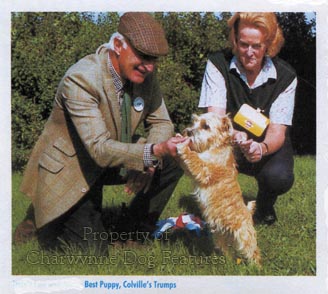 Having uniquely judged both a Lucas Terrier and a Sporting Lucas Terrier show, I carry that knowledge and experience with me when observing other sporting terriers in the ring. Terrier shows both those at country shows and those at Kennel Club authorised events have their critics, who ask: Do such terrier shows have any value? Is the judging at terrier shows really producing the true winner, actually rewarding the best dog present? Terriers can achieve a reputation above the ground as well as below it; but is it fairly earned?
Having uniquely judged both a Lucas Terrier and a Sporting Lucas Terrier show, I carry that knowledge and experience with me when observing other sporting terriers in the ring. Terrier shows both those at country shows and those at Kennel Club authorised events have their critics, who ask: Do such terrier shows have any value? Is the judging at terrier shows really producing the true winner, actually rewarding the best dog present? Terriers can achieve a reputation above the ground as well as below it; but is it fairly earned?
The bigger types of dog, especially those with a close coat, are probably easier to judge, both for a sound construction and for movement, than a small terrier, especially one with a profuse coat. It disappointing to stand ring-side at a working terrier show, especially when a so-called 'hunt terrierman' is judging, and see all manner of faults being rewarded by his placements. Of course a one-eyed heavily-scarred three-legged terrier may be the best working terrier in the county, but a show is all about appearance not reputation. I have actually seen a terrier win a first prize whilst suffering from a luxating patella; but that was at Crufts!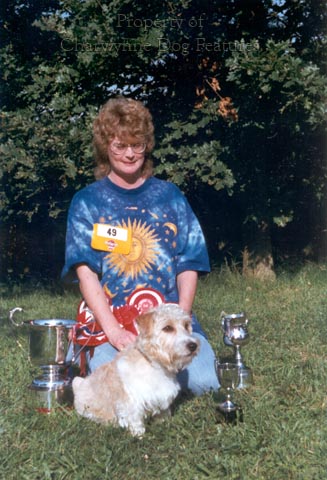
"First of all make certain that you have the sort of terrier whose build will enable him to do his job effectively and with ease to himself." That quaintly worded advice was offered sixty years ago by the field sports enthusiast and working terrier devotee, Major GB Ollivant. But what build does enable the earthdog to do his job not only well but more easily? Mr OT Price, that legendary old terrierman, who sustained his own type of terrier from 1896 to the 1950s, opted for a dog "Twelve inches in height, about three and a half in breadth and weighing about twelve pounds." "I like a narrow eel-like terrier" he used to counsel. He wasn't advocating a skinny dog but one with a supple pliant very flexible torso.
Geoffrey Sparrow, in his classic 'The Terrier's Vocation', goes for a dog "...weighing from twelve to sixteen pounds, with a strong jaw -- not snipey like the show breeds -- a good back, neck and shoulders, and fairly long legs. The length doesn't matter. They can be folded up while bad shoulders cannot." He would not have liked the Fox Terriers in contemporary Kennel Club show rings, with their upright shoulders and anteater muzzles. If they could actually get underground, they are unlikely to re-emerge!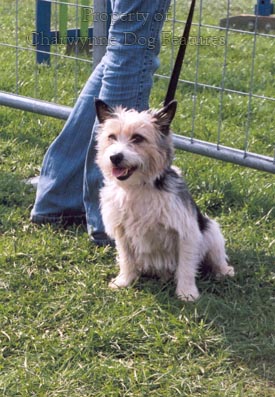
But I'll go back to Major Ollivant for a most interesting description of the physique of his terriers: "The conformation I have always found the best for a Working or Hunt Terrier is that which approaches the nearest in build to the short-backed short-legged hunter...like the short-legged hunter he must have long, well laid back, sloping shoulders, a short back and big long galloping quarters. This conformation will make him stand over a lot of ground, in spite of the fact that his back is short and not long." As he didn't specify proportions, it is arguable what he really meant by the word 'short' in connection with backs. Most wild creatures which live underground have been shaped by nature to have relatively long backs.
Dan Russell, in his admirable 'Working Terriers', states "Fourteen pounds should be the weight to seek for...Length of leg does not matter a great deal. A long-legged dog can get down a surprisingly small hole if he is narrow chested...The dog to refuse instantly is the one with loaded shoulders or turned-out elbows or a wide cobby chest." In the same vein, William Baker, one of the breeders who developed the Sealyham, has put on record: "In my opinion, no Terrier for underground work should be coarse in his shoulders, but my experience teaches me that nature decrees that a certain width of chest is always there in the gamest of them. The Sealyham of today is verging on a fancier's craze..." When I hear of working terriermen utilising show dog blood to achieve a physical point, I recall the words of Geoffrey Sparrow on this subject: "...but then she had a working pedigree back to the nineties on both sides. The real blood must be there or the pups are sure to throw to soft lines."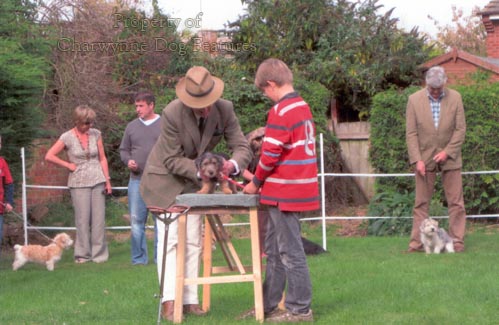
The Rev John Russell's own description of his ideal terrier as manifested in his renowned 'Trump' is worth quoting: "Her colour was white, with just a patch of dark tan over each ear and a similar dot not larger than a penny piece over the root of her tail. The coat, which was thick, close and a trifle wavy, was well calculated to protect the body from the wet and cold. The legs were straight, short and thick, and the feet perfect, while the size was equal to that of a full-grown vixen fox, that is to say, her weight was about twelve pounds. Her whole appearance gave indications of courage, endurance and hardihood."
It is interesting to compare the great man's words with those of the standard first proposed by the Parson Russell Terrier Club. This early official club blueprint stated: "Coat -- rough, a trifle wiry or smooth. Dense with belly and undersides not bare...Forelegs -- strong and straight with joints in correct alignment. Elbows hanging perpendicular to the body, working free of the sides." (I'm not sure I want a dog answering to that description!) There was no indication of what the dog's general appearance should be like; I think I'll stay with the vicar! Any pedigree Parson Russell dog which is less than 13" at the shoulder does not meet the requirements of the official KC breed standard. This means that the best working Jack Russell in the whole country could not win in the KC show ring entirely on grounds of size. Is that the best way to judge sporting terriers? 
I'm not surprised to read the judge's critique a few years ago from a National Terrier Championship show which stated: "I'd hoped to find more of the West Country original Parson types but sadly, there were few who looked like them. We seem to be moving towards a modern day PJRT which wasn't at all what was intended when the club was revived some ten years ago." Another judge at a different show gave this report: "I was disappointed with the quality of my entry, too many had heavy cheeks, absolutely foreign to the Standard." At Crufts a few years back, the Lakeland Terrier judge used these words in his show report: "On the whole the standard of Lakelands at this show were (sic) not of a very high standard, some nice ones, some not so nice, and some absolute rubbish." I do hope those working Lakeland terriermen who resort to show dog blood occasionally choose wisely! The myth of the association between pedigree and quality is surely finally acknowledged by sportsmen of all styles.
At a Scottish KC Championship show a few years back, the judge recorded: "When recognition of the PJRT took place I was under the impression that we were going to preserve the look of this old type of working terrier, it now seems that some breeders with no knowledge of, or regard for, the traditional type are determined, with the help of judges with no breed type experience, to change completely the character and look of the breed." That, in comparatively few words, sums up very aptly what happens to terrier breeds in the KC show rings. When judging the build of a working terrier, let's be guided by the wise words of our Major Ollivant: "A terrier that has to work underground must have his heart in the right place; then if his body permits him to do so, he will get there like the good sportsman he is." The only reason why we have working terriers to breed from nowadays is that countrymen who were real terriermen kept their heads over many years and ignored the financial allure of the KC show rings.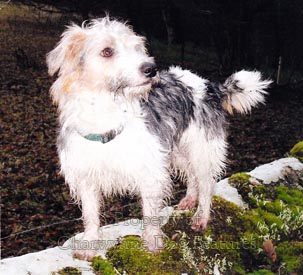
Pedigree livestock is still judged to a scale of points; pedigree dogs are no longer. Subjective judgements can bring fine differences of opinion to the fore. But for a sporting terrier to win a prize in any ring with upright shoulders, splay feet, a wry mouth and a stiff inflexible torso, as I witnessed last summer, is more than depressing. If countrymen can't judge a dog these days, what hope for urban judges at Kennel Club shows? If the terrier shows at such prestigious venues as Harrogate and Weston Park are to remain valued and their winning dogs revered, the basic elements of a soundly-constructed sporting terrier need to be understood.
It might assist newcomers to the Sporting Lucas Terrier, as a breed, to be provided with a photograph of the best specimen of the breed yet bred, one advertising all the essential breed points. Coat texture is more important than coat colour; soundness is more important than a flashy appearance. A beau ideal, like the famous depiction of early Bulldogs Rosa and Crib, can influence new breeders, who thereby get a picture of the breed beyond words. The breed standard is clearly written but a clear depiction of what is wanted takes that information a stage further. The only omission in an image is temperament, but that can be provided by both the breed standard and by the breed elders striving to influence breeding stock so that companion dogs are produced and not just good physical specimens. These are early days in the breed but crucial ones.